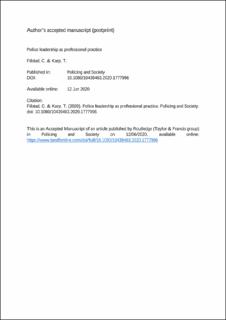Police leadership as a professional practice
Peer reviewed, Journal article
Accepted version
Permanent lenke
https://hdl.handle.net/11250/2673178Utgivelsesdato
2020Metadata
Vis full innførselSamlinger
Originalversjon
Filstad, C. & Karp, T. (2020). Police leadership as a professional practice. Policing and Society. doi: 10.1080/10439463.2020.1777996Sammendrag
In this paper, we ascertain whether a practice-based approach can increase our knowledge of police leadership. This approach represents an alternative to normative management models which have dominated the management literature. The normative approach often focuses on how police leaders must lead as well as on the traits and skills of police leaders. In contrast, our focus is on what leaders do and why and, therefore, what constitutes their professional leadership practices. We conducted qualitative explorative studies with Norwegian police leaders in 2016 and 2018. Our data were collected through the following means: a one-day shadowing of 27 police leaders, six weeks of fieldwork, 63 formal interviews of police leaders and a substantial number of informal conversations with police leaders and subordinates. In our analysis of leadership as practice, we recognise the importance of structural, cultural and contextual conditions as well as the emergent and dynamic nature of leadership practices. We identified four important practice dynamics: producing, relating, interpreting/sensemaking and negotiating. These practice dynamics were concerned with the relationships between leader(s) and employees, often characterised by the following. ‘Taking care of each other’ and ‘us against them’ within a leadership practice. Interpretations and sensemaking of the ‘reality’ within practices and production of policing as collective achievements. The language, symbols; artefacts, the police mission in relation to how it belongs/identifies with the practice and the negotiations of police leaders ‘fighting’ for resources (silos). And the continuously creation of manoeuvring spaces in what constitute police leaderś professional practice.
